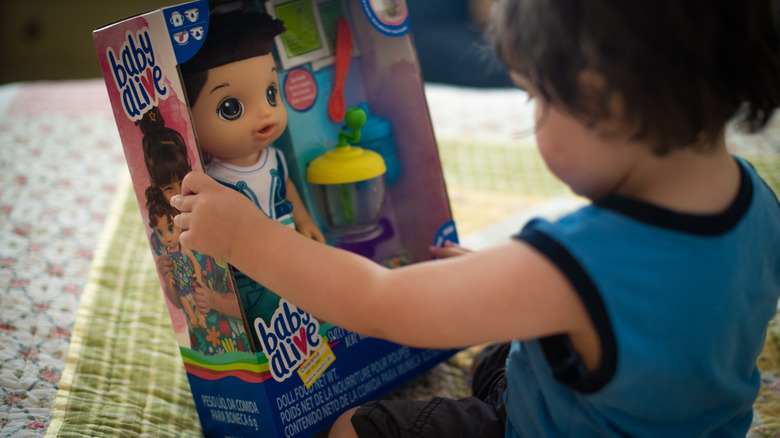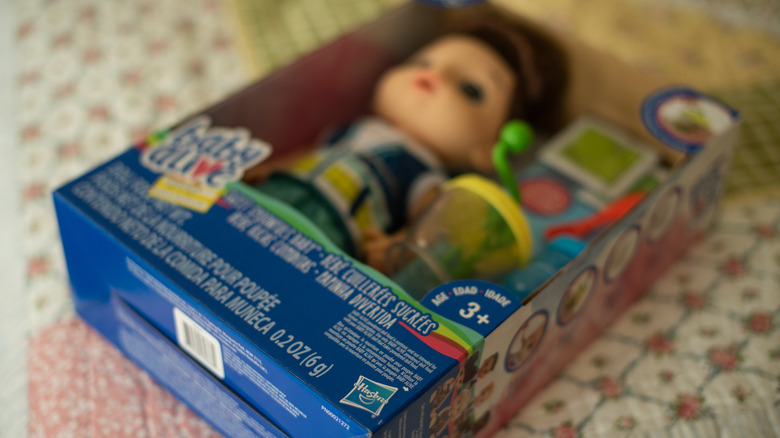Whatever Happened To Baby Alive Dolls?
Children have play-acted parenthood with toy dolls for generations, but in 1973, Kenner Products toy company redefined the experience with a product called Baby Alive. By design, kids fed Baby Alive dolls a brightly-colored, Play-Doh-like, nontoxic food-grade substance mixed with water, which the doll seemed to chew up and then poop or pee out in a diaper. While diaper changing is not most parents' idea of a good time, Baby Alive dolls were a hit, and although they might not be as quite popular as they once were, they're still sold today.
Baby Alive dolls were the brainchild, so to speak, of then Kenner president Bernard Loomis, and the questionable nature of the concept — a toy with a functioning digestive system — was not lost on his colleagues. Loomis banked on that so-called "eww factor," though, and once focus-group tested, kids seemed to love it. Five years after the product came out, Loomis told Cincinnati Magazine that his idea helped Kenner become "a major doll manufacturer." But while the toy racked up millions, the real cash cow for Kenner were replacement diapers and food packets, outselling the dolls three-to-one in the early 1980s, according to New York Magazine.
Baby Alive and TV marketing
Another secret to Baby Alive dolls' success was an extensive TV marketing strategy. When they first hit the market, the toys were relatively cheap, and retailers made slim margins, overcome by demand from TV. In 1992, Kenner marketing director Laura Pugh called that the "I want it factor." Pugh said, "For all the dolls that walk, and talk, and sing, and whatever they do, there is nothing compared to eating and relieving, or whatever you want to call it." Reportedly, the exact workings of the "digestive" system was kept proprietary.
Hasbro bought Kenner in 1991, and around that same time the dolls were updated with new food flavors like cherry, banana, and sweet pea. In 1992, a talking version was introduced, letting the owner know it had to go, but that doll was discontinued. Over the years Baby Alive dolls have seen redesigns and other updates, and they're made today with different hair and skin colors, new accessories, and other added features.
One version, the Baby Alive Sweet Tears Baby, released in 2017, speaks more than 30 phrases in English and Spanish. It also drinks from a juice box, seems to cry real tears, and in case you're wondering — kids still have to change its diaper.
Baby Alive horror stories
Although incredibly popular all over the world, a pooping-and-peeing toy did not give every child sweet dreams, as ABC Radio Sydney found out in 2020. That year, the Australian broadcaster asked its listeners to share their Baby Alive Doll stories — some heartwarming, others harrowing. "My cousin killed Baby Alive on day one by blocking her food tube with Smarties," one person said. Failing to realize there were electrical components, one person recalled mistakenly taking the doll into the bath and breaking it. Their dad had to "scalp" the doll to try and fix it. "I have never been the same," they said.
Meanwhile, another parent remembered, "I bought a Baby Alive doll for my daughter back in the mid-1970s. Baby Alive needed a [pacifier] in her mouth so she wouldn't cry. We were on the night train, in a six-seat compartment traveling north. Everyone was asleep when Baby Alive's dummy came out and she started to cry, waaah, waah, waaah. I couldn't find the [pacifier] so in the dark I stuck a bobby pin into Baby Alive's mouth to shut her up."
There were fond memories shared, too. "I still remember getting a beloved Baby Alive over 45 years ago, waking up so early, Santa had put her in my stocking before 5 a.m.," one person added. Still, the doll made a "robotic sound, "which their sibling found disturbing.

